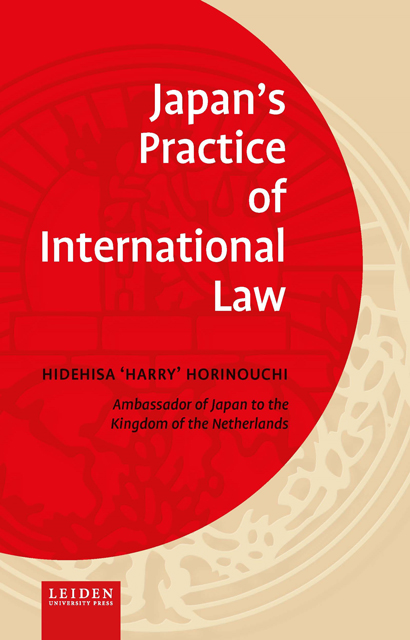Book contents
- Frontmatter
- Dedication
- Contents
- Foreword
- Chapter I Security and the Right of Self-Defense: 8 Hours on September 11
- Chapter II The End of the War: How World War II ended in Asia
- Chapter III The Remnants of War: Chemical Weapon: Poisonous Gas Accident in Qiqihar City, Heilongjiang Province
- Chapter IV Waters: Spy Vessel Incident in the Southwest Waters of Kyushu
- Chapter V Consular Affairs: Japan-China Consular Agreement:* Trajectory from the Shenyang Consulate-General Incident
- Chapter VI Human Rights of a Hijacker: CAAC Flight Hijacking Incident
- Epilogue
Chapter V - Consular Affairs: Japan-China Consular Agreement:* Trajectory from the Shenyang Consulate-General Incident
Published online by Cambridge University Press: 12 January 2023
- Frontmatter
- Dedication
- Contents
- Foreword
- Chapter I Security and the Right of Self-Defense: 8 Hours on September 11
- Chapter II The End of the War: How World War II ended in Asia
- Chapter III The Remnants of War: Chemical Weapon: Poisonous Gas Accident in Qiqihar City, Heilongjiang Province
- Chapter IV Waters: Spy Vessel Incident in the Southwest Waters of Kyushu
- Chapter V Consular Affairs: Japan-China Consular Agreement:* Trajectory from the Shenyang Consulate-General Incident
- Chapter VI Human Rights of a Hijacker: CAAC Flight Hijacking Incident
- Epilogue
Summary
Introduction
“China detains North Koreans in Japanese Consulate-General?”, “Japanese side protests … requests hand over”, “China argues it complied with the convention”: headlines of articles that appeared in the newspapers dated May 9, 2002. The outbreak of the Shenyang Consulate- General incident was reported on TV with lively footage, and shocking photographs adorned newspapers and magazines. The government of Japan strongly protested the Chinese government over the application of international law (Vienna Convention on Consular Relations), and the diplomatic authorities of both countries were in sharp conflict. Nevertheless, the Ministry of Foreign Affairs and the Consulate-General received unforgiving criticism from within Japan, and the government’s response was taken up severely every day in the Diet.2 Eight years after this incident, in January 2010, the two foreign ministers exchanged instruments of ratification for the Japan-China Agreement on Consular Relations in Tokyo, which meant the first bilateral consular agreement for Japan in 43 years. In this paper, I will look back on the trajectory of the eight years since the occurrence of the Shenyang Consulate-General Incident, discuss the issues that the Japanese government had to tackle, and clarify what kind of conclusions the bilateral agreement had reached on the issues of international law.
The author was directly involved in the handling of the case, the launch of negotiations on international agreement, and the actual negotiations as the director of the Chinese Division of the Foreign Ministry of Japan at the time of the Shenyang incident and then as the minister of the Japanese embassy in Beijing. However, the views expressed in this paper do not represent the views of the government or the Ministry of Foreign Affairs, except for direct citations such as parliamentary statements and external announcements.
First appearance of the paper: “Japan-China Consular Agreement: Trajectory from the Shenyang Consulate-General Incident”, Yuuhikaku, Jurist, No. 1402, June, 2015.
Shenyang Consulate-General Incident and remaining issues
1 The Case
Around 3:00 p.m. on May 8, 2002, armed police officers of China chased North Korean defectors (a total of five men and women, including infants) who tried to enter the Consulate-General of Japan in Shenyang, the capital of Liaoning Province, China. The incident occurred when the police officers entered the premises without obtaining the consent of the Consulate-General and took the North Koreans away.
- Type
- Chapter
- Information
- Japan’s Practice of International Law , pp. 89 - 118Publisher: Amsterdam University PressPrint publication year: 2022

